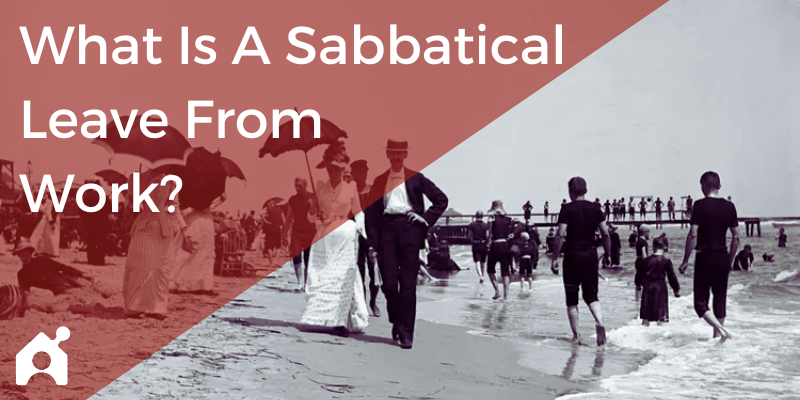What Is A Sabbatical Leave From Work?

Companies have started to adopt a concept that has roots dating back to ancient times—the sabbatical leave. But what exactly is a sabbatical leave from work? How does it work, who is it for, and why is it becoming more prevalent in today’s workplace?
This article answers the question, “What is sabbatical leave?” You’ll see a number of angles to answer that question – a simple definition, the various types and typical durations, prevalence across industries, and the history of sabbaticals.
Use the links below to jump to a section that interests you:
- What is sabbatical leave? (Definition)
- Types Of Sabbatical Leaves
- Common Lengths of Sabbatical Policies
- Industries That Offer Sabbaticals
- Sabbatical Leave Program Examples
- History Of Sabbaticals
What is sabbatical leave? (Definition)
I defined the term first in this article with every company that offers sabbaticals:
A sabbatical leave is an uninterrupted period of time during which an employee takes time off from work, while retaining their employment with the company.
A work sabbatical provides employees with the opportunity to step away from their regular duties to focus on personal enrichment and professional development. During the sabbatical, the employee keeps his or her job with a guarantee to return to their role after the break.
A sabbatical is different than paid vacation time for a few reasons:
- It’s typically used as a time for self-discovery, learning, and growth. This could mean anything from mastering a new skill, delving into research, traveling, or even contributing to a community through volunteering.
- It’s all taken at once. Paid time off (PTO) is spread throughout the year whereas a sabbatical is taken in one continuous block of time.
- Sabbaticals are typically earned after a certain milestone at the company, whereas vacation time is accrued as you work.
See Also: Sabbatical Leave: Should Your Company Offer A Program? | How To Propose & Take A Sabbatical From Work
Types Of Sabbatical Leaves
There are several types of sabbaticals that people can take, whether it’s through an employer or personally (between jobs or as a self-employed person, etc.). We’ve come up with three categories of sabbaticals to explain them:
- Types of sabbaticals offered by organizations
- Types of personal sabbaticals
- Purposes for the sabbatical
Some sabbatical types simply describe the relationship between the employer and the employee:
Paid Sabbatical
In this case, the employee continues to receive their income while on a sabbatical.
Unpaid Sabbatical
The employee retains their job but doesn’t receive a salary during the sabbatical period.
Other types of sabbaticals are done personally (without an employer):
Personal Sabbatical
This is a break from employment for personal reasons. It could be for self-improvement, relaxation, pursuing a hobby, or other personal goals.
Career Break Sabbatical
This is a planned break to evaluate career paths, consider different fields, or even start their own businesses.
Other sabbatical types describe the purpose for the break:
Educational Sabbatical
This sabbatical is a specific break to pursue a course, degree, or certification.
Medical Sabbatical
This type of sabbatical is typically used when an employee has a serious health issue that needs to be addressed.
Travel Sabbatical
This is time off to travel and explore new places.
Volunteer Sabbatical
This is a break from work to offer volunteer services, typically in a nonprofit or community setting.
Professional Development Sabbatical
A relatively less common but growing trend, these sabbaticals are specifically designed to allow employees to gain new skills, knowledge, or experiences that can enhance their careers.
Research Sabbatical
This is common in academia where professionals might take time off to focus exclusively on a research project.
Family Sabbatical
Life events such as the birth or adoption of a child, caring for an ailing family member, or dealing with personal health issues can prompt an employee to take a sabbatical.
Common Lengths of Sabbatical Policies
Sabbaticals can vary in length depending on company policies and the type of sabbatical being taken. However, we spotted some common trends in our research about the companies that offer sabbaticals:
- Sabbatical length: Approximately 50% of companies allow employees to take a one-month sabbatical, often stated as “four weeks” or “30 days.”
- Sabbatical eligibility: The most common eligibility requirement is after five years of service, although some companies offer sabbaticals as early as four years into an employee’s tenure. It’s also not uncommon for some organizations to offer sabbatical opportunities every five years of employment, thereby creating a recurring opportunity for extended rest and rejuvenation.
Industries That Offer Sabbaticals
Here are some industries where we’ve found sabbaticals offered by more than one or two rogue companies:
Academia
Professors, researchers, and other academic professionals often use sabbaticals for research or writing projects. Universities and colleges typically have well-established sabbatical policies to encourage ongoing learning and contributions to the body of knowledge in their respective fields.
Tech Industry
Many tech giants such as Adobe, Intel, and Autodesk offer sabbatical programs as a part of their benefits package. These are designed to help employees avoid burnout, stay innovative, and maintain work-life balance in a rapidly-evolving industry.
See Also: The Best Tech Companies To Work For
Non-Profit Organizations
Sabbaticals are often offered to help employees recharge and maintain their passion for their work, or to offer employees a chance to volunteer for the cause they support.
Consulting Firms
Several large consulting firms have established sabbatical policies. These offer consultants a chance to take a break and return to their work with renewed energy and perspective.
Medical Institutions
Health professionals, particularly those in high-stress areas like surgery or emergency medicine, may take specific types of sabbaticals to pursue further training, engage in research, or simply recharge.
Finance and Accounting Firms
Firms in these sectors often provide sabbatical programs to help employees manage the high stress associated with the job.
Remember, while these industries commonly offer sabbaticals, the specifics of the programs can vary greatly from one organization to another. It’s always important to understand the particular policy of your own workplace.
Sabbatical Leave Program Examples
A growing number of companies are recognizing the value of offering sabbaticals as a part of their benefits package. Here are some forward-thinking organizations that offer paid sabbaticals across tech, healthcare, banking, consumer foods, and more:
- Adobe: 4 weeks after 5 years
- Blue Cross Blue Shield: 4 weeks after 5 years
- Bank of America: 4 weeks after 15 years
- Charles Schwab: 28 days after 5 years
- General Mills: 6 weeks after 4 years
- Intel: 8 weeks after 7 years
- McDonald’s: 8 weeks after 10 years
- Microsoft: 8 weeks after 10 years
- Nike: 5 week after 10 years
- Shopify: 4 weeks after 5 years
History Of Sabbaticals
How did the idea of a sabbatical come about? You first need to start back hundreds of years ago with “The Sabbath.”
Early Origins: The Sabbath Year
The roots of the sabbatical can be traced back to an ancient biblical tradition, often referred to as the “Sabbath year” or “Shmita.” According to this Jewish law, farmers in the Land of Israel were required to take a year-long break from working the fields every seven years.
Shmita comes from Book of Exodus:
“For six years you are to sow your land and to gather in its produce, but in the seventh, you are to let it go [tishm’tenah] and to let it be [u’nitashta], that the needy of your people may eat, and what remains, the wildlife of the field shall eat.”
This not only provided the land with a period of rest, rejuvenating its fertility for future harvests, but also embodied a spiritual and societal reorientation toward communal care and social equity.
19th Century Academia: The Modern Sabbatical
Fast forward to the late 19th century to the early 20th century, and we find the genesis of the modern concept of sabbaticals in academia. According to this paper by Bai Kang and Michael T. Miller:
“…Sabbatical leave programs began at Harvard University in 1880, with professors granted a year of leave at half-pay every seventh year. By the early 1930s, 178 institutions had started this practice.”
Typically, professors were encouraged to take a year off every seven years to focus on their research, travel, or simply rest. The underlying belief was that this extended break would increase their knowledge and, in turn, their effectiveness as teachers and researchers upon return.
Mid-20th Century: Extension into Other Sectors
During the mid-20th century, the sabbatical began to make its way into other sectors. In 1977, McDonalds introduced the first well-known paid sabbatical program in the corporate world.
This marked the transition from universities to companies.
Modern Era: The Evolving Workplace
Today, people are much more focused on work-life balance and well-being.
As a way to compete for talent and retain and refresh existing employees, many organizations have implemented sabbatical policies. While academia still leads in the frequency of sabbatical leaves, tech companies, non-profits, and even government agencies have begun to recognize the value of providing their employees with an extended break. Today’s sabbaticals have evolved beyond just rest and relaxation, often serving as an opportunity for employees to pursue personal interests, gain new skills, or contribute to their communities in meaningful ways.
Sabbatical leaves offer a unique opportunity for employees to take a step back from their day-to-day responsibilities, rejuvenate, pursue personal interests, or dive into new learning experiences, all while maintaining the security of their employment. As we’ve seen, the concept has evolved significantly from its early biblical origins to its academic adoption in the 19th century, and its widespread application in modern times.
If your company doesn’t offer a sabbatical leave, it might be worth initiating a conversation about how to take a sabbatical leave or starting a sabbatical program —it could become a vital part of the future of work.
| We’ve covered work sabbaticals in depth. Want to learn more about sabbatical leave from a different angle? |
